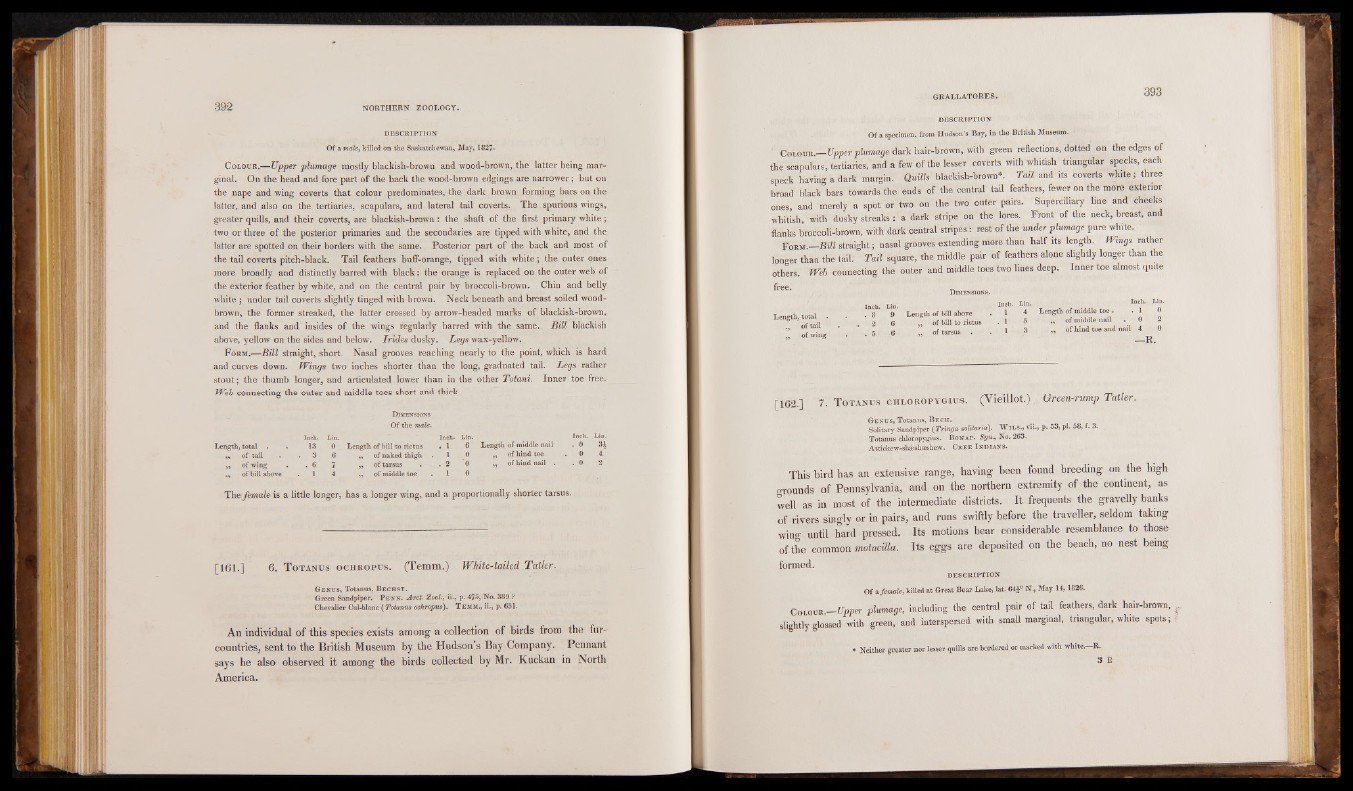
DESCRIPTION
Of a male, killed on the Saskatchewan, May, 1827«
Colour.—Upper plumage mostly blackish-brown and wood-brown, the latter being marginal.
On the head and fore part of the back the wood-brown edgings are narrower ; but on
the nape and wing coverts that colour predominates, the dark brown forming bars on the
latter, and also on the tertiaries, scapulars, and lateral tail coverts. The spurious wings,
greater quills, and their coverts, are blackish-brown: the shaft of the first primary white ;
two or three of the posterior primaries and the secondaries are tipped with white, and the
latter are spotted on their borders with the same. Posterior part of the back and most of
the tail coverts pitch-black. Tail feathers buff-orange, tipped with white; the outer ones
more broadly and distinctly barred with black: the orange is replaced on the outer web of
the exterior feather by white, and on the central pair by broccoli-brown. Chin and belly
white ; under tail coverts slightly tinged with brown. Neck beneath and breast soiled wood-
brown, the former streaked, the latter crossed by arrow-headed marks of blackish-brown,
and the flanks anchinsides of the wings regularly barred with the same. Bill blackish
above, yellow on the sides and below. Irides dusky. Legs wax-yellow.
Form.—Bill straight, short. Nasal grooves reaching nearly to the point, which is hard
and curves down. Wings two inches shorter than the long, graduated tail. Legs rather
stout; the thumb longer, and articulated lower than in the other Totani. Inner toe free.
Web connecting the outer and middle toes short and thick.
Dimensions
Of the male.
Length, total 13
Lin.
0 Length of bill to rictus
Inch. Lin.
. 1 6 Length of middle nail . 0
Lin.
3^
,, of tail . 3 6 ,, of naked thigh . 1 0 ,, of hind toe . 0 4
’,, of wing . . 6 7 ,, of tarsus . 2 0 ,, of hind nail . . 0 2
,, of bill above . 1 4 ,, of middle toe . 1 0
Thet female is a little longer, has a longer wing, and a proportionally shorter tarsus.
[161.] 6. T otanus o c h r o pu s . (Temm.) White-tailed Tatler.
Genus, Totanus, Bechst.
Green Sandpiper. Penn. Arct. Zool., ii., p. 475, No. 389 ?
Chevalier Cul-blanc ( Totanus ochropus). Temm., ii., p. 651.
An individual of this species exists among a collection of birds from the fur-
countries, sent to the British Museum by the Hudson’s Bay Company. Pennant
says he also observed it among the birds collected by Mr. Kuckan in North
America.
DESCRIPTION
Of a specimen, from Hudson’s Bay, in the British Museum.
' Colour.—Upper plumage dark hair-brown, with green reflections, dotted on the edges of
the scapulars, tertiaries, and a few of the lesser coVerts with whitish triangular specks, each
speck having a dark margin. Quills blackish-hrown*. Tail and its coverts white; three
broad black bars towards the ends of the central tail feathers, fewer on the more exterior
ones and merely a spot or two on the two outer pairs. Superciliary line and cheeks
whitish, with dusky streaks: a dark stripe on the lores. Front of the neck,, breast, and
flanks broccoli-brown, with dark central stripes: rest of the under plumage pure white.
p ORM__Bill straight; nasal grooves extending more than half its length. Wings rather
longer than the tail. Tail square, the middle pair of feathers alone slightly longer than the
others. Web connecting the outer and middle toes two lines deep. Inner toe almost quite
free. „Dimensions.
Inch. Lin.
Length, total . . . 8 9
„ ' of tail . . 2 6
„ of wing • * 5 6
Inch. Lin.
Length of bill above . 1 4
,, of bill to rictus . 1 5
„ of tarsus . . 1 3
Inch. Lin.
Length of middle toe . . 1 0
„ of middle nail . 0 2 „ of hind toe and nail 4 0 —R.
[162.] 7. T otanus c h l o r o p y g iu s . (Vieillot.) Green-rump Tatler.
GSoelnituarsy, STaontadnpuipse, rB (Tecrihng. a solitaria). Wins., vii., p. 53, pi. 58, f. 3.
Totanus chloropygius. Bonap. Syn., No. 263.
Attickew-shèshæshew. Créé Indians.
This bird has an extensive range, having been found breeding on the high
o-rounds of Pennsylvania, and on the northern extremity of the continent, as
well as in most of the intermediate districts. It frequents the gravelly banks
of rivers singly or in pairs, and runs swiftly before the traveller, seldom taking
wing until hard pressed. Its motions bear considerable resemblance to those
of the common motacilla. Its eggs are deposited on the beach, no nest being
Of a female, killed at Great Bear Lake, lat. 64£° N., May 14, 1826.
Colour .-Upper plumage, including the central pair of tail feathers, dark hair-brown,
slightly glossed with green, and interspersed with small marginal, triangular, white spots;
* Neither greater nor lesser quills are bordered or marked with white. R.